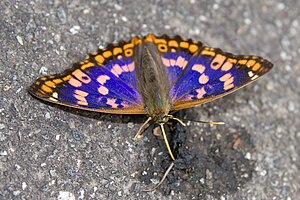Apatura metis
| Apatura metis | ||||||||||
|---|---|---|---|---|---|---|---|---|---|---|

Apatura metis , male |
||||||||||
| Systematics | ||||||||||
|
||||||||||
| Scientific name | ||||||||||
| Apatura metis | ||||||||||
| Freyer , 1829 |
Apatura metis , sometimes also referred to as the Danube Schiller butterfly or Eastern Schiller butterfly , is a butterfly (day butterfly ) from the noble butterfly family(Nymphalidae). In English usage , the species is referred toas Freyer's Purple Emperor in honor of the first person to describe it, Freyer . The Art epithet of the Greek is Oceanid Metis dedicated.
features
butterfly
The fore wing length of the moth is 26 to 30 millimeters. The species shows a slight sexual dimorphism , which is expressed by the fact that only the males show a metallic bluish shimmer on the brownish wing tops when exposed to appropriate light. In the submarginal region , a reddish-brown, slightly interrupted marginal band stands out on all wings. Other bright spots are distributed over the wings. An eye spot on the upper side of the forewing is located in an elongated, oval to square red-brown field near the outer edge. The undersides of the wings have a faded yellow-gray to yellow-brown tint, from which light bands and spots and small black dots stand out.
egg
The egg is initially gray in color, which later turns into a light green. It has the shape of a truncated cone and is provided with longitudinal ribs. A purple ring is striking.
Caterpillar
Adult caterpillars are bright green in color and have yellow lines that slope backwards in the shape of a V. Typical are the two yellowish headphones and a tapering end of the body, which gives the caterpillars the appearance of a slug .
Doll
The pupae are light green and designed as falling dolls .
Similar species
The small Schiller butterfly ( Apatura ilia ) in the Rotschiller form f. clytie is somewhat larger than Apatura metis with a fore wing length of 31 to 34 millimeters . The eye spot on the upper side of the forewing is surrounded by an almost circular red-brown field in the ilia . In addition, the reddish brown band on the upper side of the hind wing is narrower than in A. metis .
distribution and habitat
Apatura metis is locally distributed in south-eastern Europe and parts of Asia. The species occurs at altitudes of up to 650 meters. River banks where white willows grow, such as the lower reaches of the Danube and Drava, are preferred .
Subspecies
The following subspecies are distinguished:
- Apatura metis metis Freyer , 1829, (Southeast Europe). If the edge band is white, it is called Form coelestina Grum-Grishmailo , 1884.
- Apatura metis bunea Herrich-Schäffer , 1845, (Southern European part of Russia , Northern Caucasus ), synonyms: gertraudis Stichel , [1909]; oberthueri Le Moult , 1947
- Apatura metis substituta Butler , 1873, ( Japan ), synonyms: gifuensis Matsumura ; takanonis Matsumura 1919; yanagawensis Matsumura 1928, japonica Le Moult , 1947
- Apatura metis irtyshika Korshunov , 1982, (Southwest Siberia , Kazakhstan )
- Apatura metis separata Tuzov , 2000, ( Transbaikalia )
- Apatura metis heijona Matsumura , 1928, ( Korea , Amur and Ussuri regions ), synonyms: gracilis O. Bang-Haas , 1936; asiatica Le Moult , 1947; mirei Le Moult , 1947. If the edge bandage is white, it is called Form krylovi Kurentzow , 1937 (Syn .: abramovi Kurentzow , 1970).
- Apatura metis doii Matsumura , 1928, ( Kuril Islands )
Way of life
The moths fly in two generations from late May to late June and again from mid-July to early September. In southern Russia, only one generation is trained in June and July. The females lay the eggs individually or in small groups on the upper side of the leaf of the forage plant. In the first stage, the young caterpillars have no horns on their heads. These form after the first molt. After the second moult, they overwinter in the cracked bark of white willow trunks on the side of the trunk facing away from the sun and pupate in early May of the following year. The food plant of the caterpillars is the leaves of the white willow ( Salix alba ) and probably ripe willow ( Salix dapnoides ) in the European part and Salix schwerinii in the Ussuri region.
The males of Apatura metis are attracted to strongly smelling substances. These include excrement or carrion from which they suck the minerals they need to achieve fertility. In contrast, the females were observed suckling overripe fruits, for example mulberries lying on the ground . The moths also visit baits made from the aforementioned substances.
Danger
The species is usually numerous in its range and is therefore classified by the IUCN as a " least concern ".
swell
Individual evidence
- ^ Arnold Spuler: The butterflies of Europe , Volume 1, E. Schweizerbart'sche Verlagsbuchhandlung, Stuttgart, 1908
- ↑ a b c d e f g Hans-Josef Weidemann: Tagfalter: watch, determine , Naturbuch-Verlag, Augsburg 1995, ISBN 3-89440-115-X
- ↑ Tom Tolman, Richard Lewington: The butterflies of Europe and Northwest Africa , Franckh-Kosmos Verlags-GmbH & Co, Stuttgart 1998, ISBN 3-440-07573-7
- ↑ a b c d e V. K. Tuzov, PV Bogdanov, SV Churkin, AV Dantchenko, AL Devyatkin, VS Murzin, GD Samodurov, AB Zhdanko: Guide to the Butterflies of Russia and adjacent territories . Libytheidae, Danaidae, Nymphalidae, Riodinidae, Lycaenidae. tape 2 . Pensoft, Sofia 2000, ISBN 954-642-095-6 , pp. 14th f .
- ^ IUCN Red List of Threatened Species
literature
- Hans-Josef Weidemann: Butterfly: observe, determine , Naturbuch-Verlag, Augsburg 1995, ISBN 3-89440-115-X
Web links
- Lepiforum e. V. - Taxonomy and photos
- Moths and Butterflies of Europe and North Africa - Photos
- www.nic.funet.fi - Distribution and subspecies
- lepidoptera.eu - Occurrence in Europe
- Apatura metis at Fauna Europaea. Retrieved September 17, 2015

